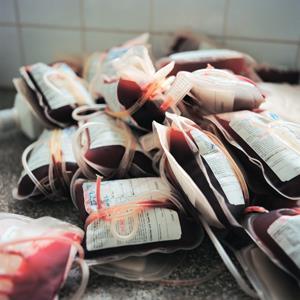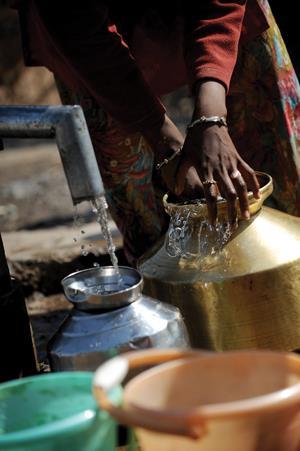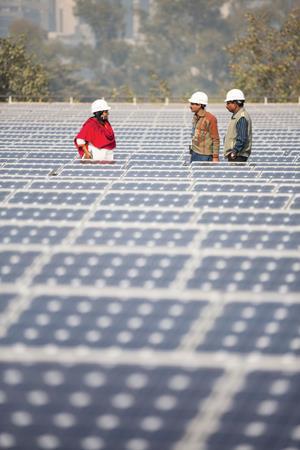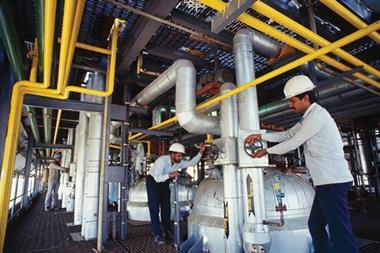India’s climate, its vast population and extremely rapid development make it host to a unique set of challenges. Sanjay Kumar finds out how Indian chemists are developing home-grown solutions

On the southern fringe of New Delhi, just next to the medieval minaret of Qutub, stands a 1600 year old iron pillar known as India’s ‘rustless wonder’ – a magnificent testament to the tantalising skills of ancient Indian metallurgists.
For centuries, the wrought iron pillar has braved rain and sunshine in the open – incessantly teasing and mystifying generations alike for its corrosion-free properties. How did the ancient Indians fashion such a massive artistic marvel – more than seven metres tall and weighing some six tonnes – believed to have been erected in the Gupta period (AD320–600)? Until the end of the 19th century, it was the heaviest known piece of wrought iron in the world.
Scientific researchers at the Indian Institute of Technology, Kanpur and Indira Gandhi Centre for Atomic Research, Kalpakkam, along with archaeologists, have thrown considerable light on the pillar since the 1990s, using non-destructive techniques to study its properties, composition and how it was made. Their conclusion: the pillar’s composition is comparable to low carbon steel with high phosphorus, low sulfur and manganese and high slag content, coated with a complex protective film of phosphate that confers high corrosion resistance.
From ancient to modern times, contributions of Indian scientists and technologists to chemistry have been significant. India continues to grapple with gargantuan problems of its billion and a quarter plus population, and Indian chemists have sometimes struggled to make a dent in their field. But while India is yet to catch up with the global cutting edge technologies, some of its interventions have made global headlines.
India’s problems often align with global challenges, yet with a unique Indian flavour. Chemists in India are working hard to find solutions that will benefit their own – and the world’s – population.
Health
India carries a huge chunk of global burden of disease – both communicable and non communicable – but the indigenous drug industry has largely been able to provide drugs for its population at comparatively affordable prices.
In some significant areas, such as antiretrovirals for treating HIV Aids, its companies confronted global multinational giants and single handedly introduced a paradigm shift in HIV treatment: prices charged by international pharmaceutical giants for antiretroviral drugs tumbled from $10,000 (£6600) to ~$200 per year when Indian companies jumped into the fray with generic versions. It became possible for millions of HIV patients in the developing world to access affordable medicines, prolong and save their lives while putting a brake on the runaway march of the Aids pandemic.
Today India is a global generics leader supplying most countries worldwide. However, Indian courts continue to settle patent wars between local drug manufacturers and multinational companies while policy makers lament the lack of enthusiasm shown internationally for treatments for neglected diseases that afflict millions in developing countries.
India’s pharmaceutical industry – employing some 4.2 million people – has a turnover of ~$24 billion, half of it coming from the rapidly growing export market. India is valued as the 4th largest drug producing country, catering to 10% of global production, according to the Indian Drug Manufacturers Association.
Boosting blood banks

With almost one death and four injuries every minute, India has the highest number of accidents in the world, and it’s growing. A total of 400,517 accidental deaths were reported in the country during 2013 – with the number of injured believed to be four times higher.
Such huge numbers mean the demand for lifesaving blood is always high. But against an annual demand of 12 million units, only 9 million are collected each year, leading to a chronic shortage. Blood transfusions to counter loss of blood are a primary driver of demand in emergencies and surgeries.
Researchers have focused on developing artificial haemoglobins or haemoglobin-based oxygen carriers as alternatives to blood donations.
Commercially, some non-blood ‘volume expanders’ such as perfluorocarbon-based carriers are available which restore lost body fluid and also carry oxygen but suffer from serious limitations as they fail to mimic the oxygen transport function of human blood faithfully.
A potent alternative is the haemoglobin based oxygen carriers (HBOCs) with haemoglobin derived from humans, animals or produced recombinantly. They have several advantages such as long shelf life, no risk of blood type mismatch or immune rejection, but pose serious problems such as hypertension, impaired oxygen binding, instability and cytotoxicity.
A major problem preventing the wider use of HBOCs is the release of toxic haem, an important component of haemoglobin, in the body. This threat limits the use of HBOCs and is difficult to suppress, making the development of HBOCs that retain their haem vital to their future.
A team of researchers from Delhi University’s department of biochemistry, led by Suman Kundu, have advanced an interesting solution to this problem that could potentially defang the release of toxic haem into the body. They discovered that the haem can be tightly bound to haemoglobin by introducing a chemical bond between the haem and a protein. They successfully engineered a covalent linkage observed in a cyanobacterial haemoglobin into a prototype myoglobin.
Researcher Sheetal Uppal tweaked one strategic amino acid, isoleucine, in myoglobin to a different amino acid (histidine) to introduce the desired bond. The engineered haemoglobin showed the same properties as normal haemoglobin, and did not release haem under experimental conditions. This unique combination of haem retention and desirable biochemical, biophysical and oxygen binding properties represents a significant step in the production of a stable blood substitute and can potentially solve shortages of blood worldwide.
Delhi University researchers hope that this proof of concept breakthrough can be replicated in the form of commercially viable haemoglobin for use as a blood substitute in the next few years, followed by animal and human clinical trials.

Food security
India’s hunger situation is classified as ‘serious’, ranking 55 on the Global Hunger Index 2014 (GHI), trailing behind Rwanda, Iraq and Nepal. India remains home to the largest number of chronically malnourished and stunted children under five, says the GHI report. With a population of over 1.28 billion and rising, India needs to constantly increase its agricultural production.
About 69% of India is arid, semi-arid and dry sub-humid or dry land. An estimated 32% of India’s total land is affected by land degradation and 25% (or ~82 million hectares) by desertification. This has severe implications for livelihood and food security for millions of people living in these areas. Soil erosion is the major cause of land degradation, and most prominent in agricultural regions, says India’s Ministry of Environment. Low and erratic rainfall coupled with extreme temperatures and intense solar radiation makes these regions most vulnerable.
Hydration through hydrogels
Agricultural chemists with the Indian Agricultural Research Institute have patented a novel semi-synthetic granular hydrogel polymer called Pusa hydrogel which helps farmers increase the efficiency of their water use in arid and semi-arid regions. The hydrogel has found a number of commercial takers, the most recent being India’s petrochemicals giant Reliance Industries.
This super-absorbent polymer exhibits maximum absorbency at temperatures of 40–50°C, absorbing water 350–500 times its dry weight and gradually releasing it into the soil. It remains stable in the soil for almost a year and requires just 1–2kg per hectare for horticultural crops and 2.5–5kg per hectare for field crops. These hydrogels degrade completely into carbon dioxide, water and ammonia within a year and are considered environmentally safe.
Extensive field trials have been conducted in India involving a diverse range of key cereals, oilseeds and other commercial crops. Positive results have been seen with crops as diverse as maize, sugarcane, soya bean and turmeric. Hydrogel use is now being extended to vegetables, fruits and flowers.
Water
Over the years, access to water has improved in both rural and urban India – despite grave challenges of both quantity and quality.

In 2011, 92% of the Indian population officially had access to improved water sources – 96% in urban areas and 89% in rural areas. But this hides an ugly reality of dubious water quality and barely adequate water availability – both of which are highly problematic and a source of often violent conflicts.
According to Unicef, 67% of Indian households do not treat their drinking water although it could be chemically or bacterially contaminated. The World Bank estimates that 21% of India’s communicable diseases are linked to unsafe water. India’s rivers are equated nationally with open sewers and the government is locked in embarrassing cases in the supreme court.
India’s Ministry of Science & Technology – which has funded nearly a dozen research teams across India – lists 26 major challenges facing water supplies in India ranging from contamination with microbes, fluorides, iron, arsenic or pesticides to low per capita water availability.
The social costs are enormous: Unicef studies show that 45% of India’s children suffer from stunted growth; and 600,000 children under five die every year due to inadequate water supply and poor sanitation.
Pure water for paisa
A research team led by Thalappil Pradeep with the nanoscience unit, chemistry department at the Indian Institute of Technology Madras, Chennai, has developed a novel affordable water purification unit based on patented nanotechnology. It costs five paisa per litre (a fraction of a penny) to rid water of arsenic contamination – widespread in west Bengal and spread over many Indian states – and just half of that to clear microbial contaminants for a family of four. And it runs without electricity.

The technology can be tailored to regional variants of pollutants such as mercury, lead, iron or pesticide residues, whereas microbial pollution is a national problem, says Pradeep, who dreams of setting up an international water centre in India to make these kinds of technologies available.
His team has developed household solutions as well as larger community-based solutions. Nearly 100 such community units are operational, serving around 100,000 people in West Bengal state, to mitigate arsenic contamination, a problem that affects millions. 900 more units are in the pipeline. It costs roughly INR270 to make water arsenic free and INR120 to treat microbial contamination for one year. The household equipment costs some INR2000.
Energy

Nearly 600 million Indians do not have access to electricity and some 700 million use biomass as their energy source for cooking. Electricity – when available, largely in urban areas – remains erratic, and the rural supply is quite dismal. Vast rural areas of the country are not connected to the electricity grid.
The government is frantically exploring any and all options for augmenting the electricity supply – from hydroelectricity to nuclear to renewable energy. There is an explosion of interest in renewable energy, especially solar energy, to meet the burgeoning demands of the population. The Indian government has announced scaling up of solar energy provision to 100,000MW in the coming five years. Off-grid solar also has a lot of potential for areas not connected to the grid, especially in rural and remote areas, inhabited by millions.
Improving capacity with ultracapacitors
Growing interest in renewable energy has led to increased focus on energy storage devices of which battery banks remain a vital component. Lead–acid batteries remain common, although restricted by a limited number of charge–discharge cycles which contributes to shorter battery life and reduced efficacy. Alternative storage devices include several kinds of electrochemical capacitors.
Researchers led by A K Shukla with the solid state & structural chemistry unit of the Indian Institute of Science, Bangalore, have developed a novel electrochemical capacitor, a lead–carbon Hybrid Ultra Capacitor (HUC) that addresses some of these key concerns and limitations. The HUC provides much faster charge–discharge rates over many thousand more cycles, has a longer shelf life and delivers higher power.
‘This technology is quite cost effective and highly suitable for rural areas unconnected with the grid,’ says Shukla. It has a long life and comes with a five year guarantee. In contrast, lead–acid batteries have a lifespan of just one year.
India in academia
Where does chemistry research in India stand? The latest available data covers the period up to 2010 emanating from two special studies commissioned by India’s Department of Science & Technology and conducted by Thomson Reuters and Elsevier.
Between 2001–05 and 2006–10, the volume of Indian research papers in chemistry increased by 51%. India’s chemistry publications had a global share of 6.5% and it ranked 9th in terms of scientific publications in 2010. In chemistry, Indian citation impact factor was 0.40 in 1981–1985 and rose to 0.50 by 1993–1997. By the 2006–2010 period, impact factor had reached 0.68. Chemistry is well represented in India’s scientific output: in 2010, India’s largest shares of world research output (by field) were in chemistry (6.5%) and materials science (6.4%). Although India’s overall share of publications in the top 1% impact making journals has been low, the number of chemistry papers in such journals increased from 685 to 797 between 2001–05 and 2006–10. More than 60% of the increase in Indian contributions to these top journals seems to have emanated from just four disciplines: engineering, chemistry, clinical medicine and materials science. It also noted a fall in the percentage of uncited papers in chemistry: in 2001–2005, some 46.2% papers were uncited; by 2006–2010, this had fallen to 39.6%.
Despite significant improvements and achievements, clearly India cannot rest on its limited laurels. ‘We have to graduate from copying molecules to creating new molecules and need to get deep into cutting edge areas’, says Raghunath Mashelkar, former director general of the Council of Scientific & Industrial Research and currently president of the Global Research Alliance. ‘In the current era, we have to raise our expectations and not just look into windows opened by others but open new windows ourselves’, he added.
Sanjay Kumar is a science journalist based in New Delhi
This article is part of our Focus on India. You can find see more comment and insightful analysis on Indian chemistry here.












No comments yet